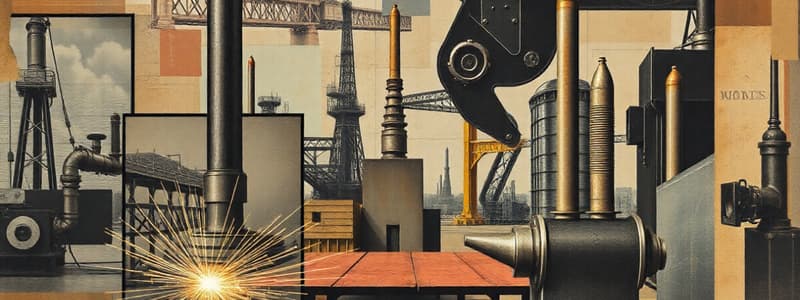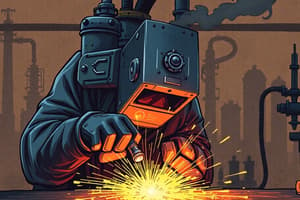Podcast
Questions and Answers
What notable figure is associated with metalworking in the mid-10th century BCE, particularly with bronze and iron?
What notable figure is associated with metalworking in the mid-10th century BCE, particularly with bronze and iron?
Tubal-Cain
What significant method of metalworking evolved during the Middle Ages that was also used in the 20th century?
What significant method of metalworking evolved during the Middle Ages that was also used in the 20th century?
Forging
What did Sir Humphry Davy contribute to the field of welding in the early 1800s?
What did Sir Humphry Davy contribute to the field of welding in the early 1800s?
He discovered that two carbon sticks connected to a battery produced an electric arc.
Why was early storage of acetylene problematic, and how was it eventually stabilized?
Why was early storage of acetylene problematic, and how was it eventually stabilized?
What safety requirements were established for using acetylene in welding or cutting?
What safety requirements were established for using acetylene in welding or cutting?
What was one reason welding became preferred over riveting during World War I?
What was one reason welding became preferred over riveting during World War I?
Who led the formation of the American Welding Society in 1919?
Who led the formation of the American Welding Society in 1919?
What is the main characteristic of metalwork as mentioned in the content?
What is the main characteristic of metalwork as mentioned in the content?
Describe the technique of embossing or repoussé in metalwork.
Describe the technique of embossing or repoussé in metalwork.
What early techniques did ancient metalworkers use that are still relevant today?
What early techniques did ancient metalworkers use that are still relevant today?
Flashcards are hidden until you start studying
Study Notes
Metalworking History
- Tubal-Cain, a metalworker, lived during the time of Solomon's Temple construction (mid-10th century BCE).
- Metalworking existed before the Iron Age.
- Forging was a common metalworking technique during the Middle Ages, used extensively in blacksmithing.
- Edmund Davy discovered acetylene, and Sir Humphry Davy discovered the electric arc, leading to arc welding.
- Acetylene storage was problematic due to its low flash point and expansion.
- Acetylene is safely stored in cylinders filled with porous material and acetone at 250 PSI.
- World War I significantly increased the demand for welding due to its cost-effectiveness and efficiency compared to riveting.
- The American Welding Society was founded in 1919 by the Wartime Welding Committee to standardize welding terminology and practices.
Metalwork
- Metalwork includes objects crafted from metals like copper, iron, silver, bronze, lead, gold, and brass.
- Metalwork has been used to create vessels, utensils, ceremonial objects, decorative items, architectural ornamentation, personal adornments, sculptures, and weapons.
- Early techniques like hammering, embossing, chasing, inlaying, gilding, and applying niello, enamel, and gems are still used today.
Techniques
- Hammering and Casting: Early metalworkers used hammers to form individual pieces that were joined with rivets or pinned.
- Embossing (Repoussé): Raising ornament in relief from the reverse side. The design is outlined on the metal, transferred to the back, and hammered into a yielding material.
- Chasing: Detailed finishing done with hammers and punches on the face of the metal, both in relief and intaglio.
- Engraving: Cutting or incising lines into metal using a cutting tool.
- Inlaying: Decorating metal surfaces by encrusting wire (gold, silver, or copper) into undercut patterns.
Steel
- Steel is manufactured from pig iron by reducing carbon and impurities and adding controlled amounts of alloying elements.
- Steel production was revolutionized by the Bessemer process, enabling the creation of skyscrapers, bridges, and railway tracks.
- Steel's properties are determined by its composition, which is specified by ASTM, ASME, SAE, and AISI.
- Carbon steel is divided into four groups: low-carbon, medium-carbon, high-carbon, and very high-carbon, each with different properties.
- High-strength steels are specified by ASTM.
- Low-Alloy, High-Strength, Tempered Structural Steel: Low-carbon steel with specific alloying elements.
- Tungsten Steel: Expensive, used for drills, lathe tools, and cutters.
- Molybdenum: A cheaper substitute for tungsten used in high-speed steel and tubing.
- Manganese Steels: Varying amounts of manganese produce steels with different properties, including strength, free-machining ability, and wear resistance.
Nonferrous Metals
- Nonferrous metals lack or have insignificant amounts of iron, and are nonmagnetic.
- Copper: Popular commercial metal, used in various alloys, and for protective coatings, ball floats, containers, and soldering coppers.
- True Brass: Alloy of copper and zinc, with added alloys for specific properties.
- Bronze: Primarily copper and tin, considered superior before steel-making techniques.
- Copper-Nickel Alloys: Nickel increases wear and corrosion resistance, used for saltwater piping and storage tanks.
- Lead: Heavy, soft, and malleable.
- Caution: Lead dust, fumes, and vapors are highly poisonous.
- Zinc: Used as a protective coating for iron or steel (galvanizing).
- Tin: Alloying element that increases corrosion resistance.
- Aluminum: Easy to work with, attractive, lightweight, and requires alloys to increase strength.
- Duralumin: A strong structural aluminum alloy, now classified as 2017-T, with "T" indicating heat-treated.
Studying That Suits You
Use AI to generate personalized quizzes and flashcards to suit your learning preferences.




